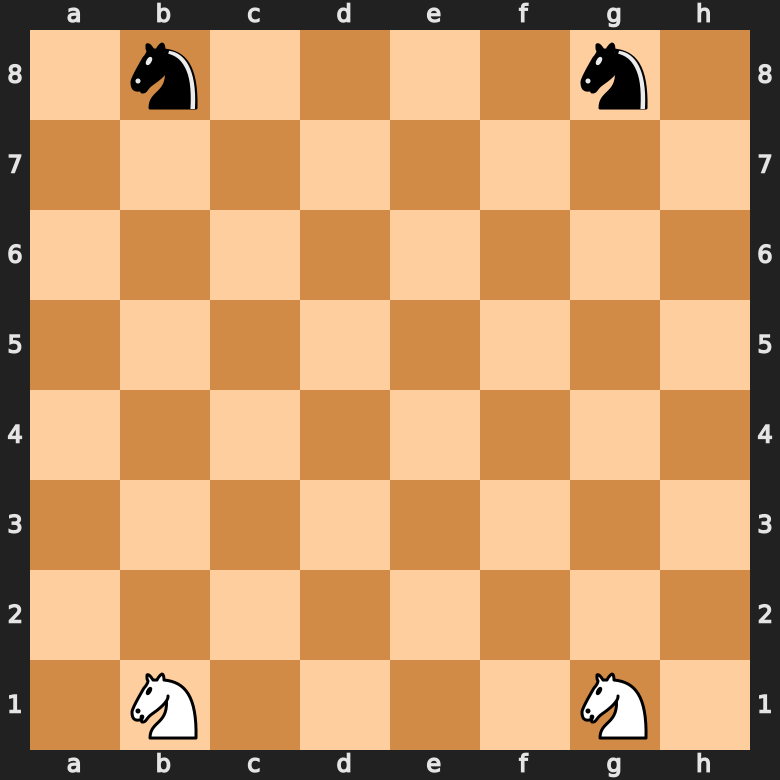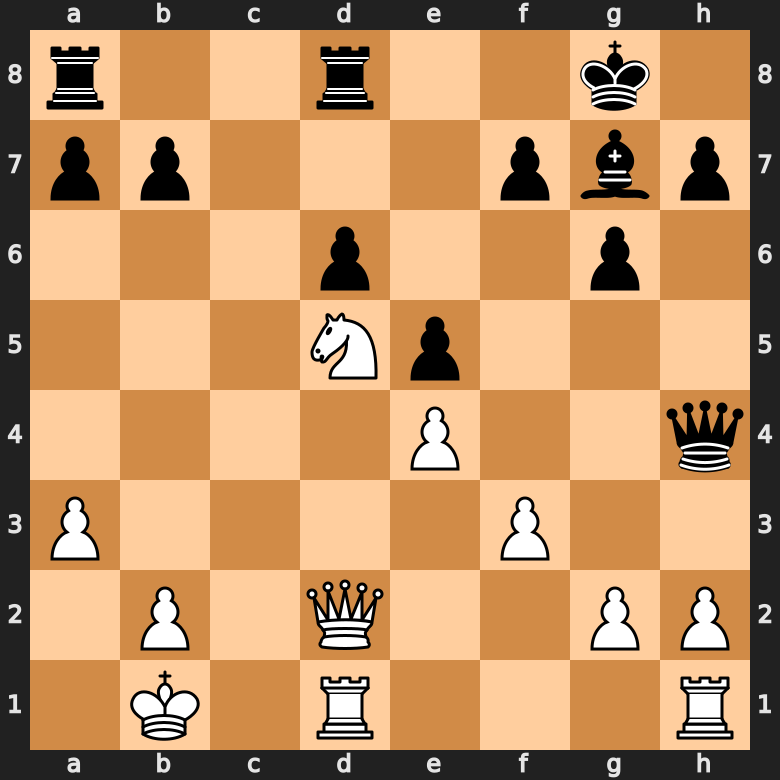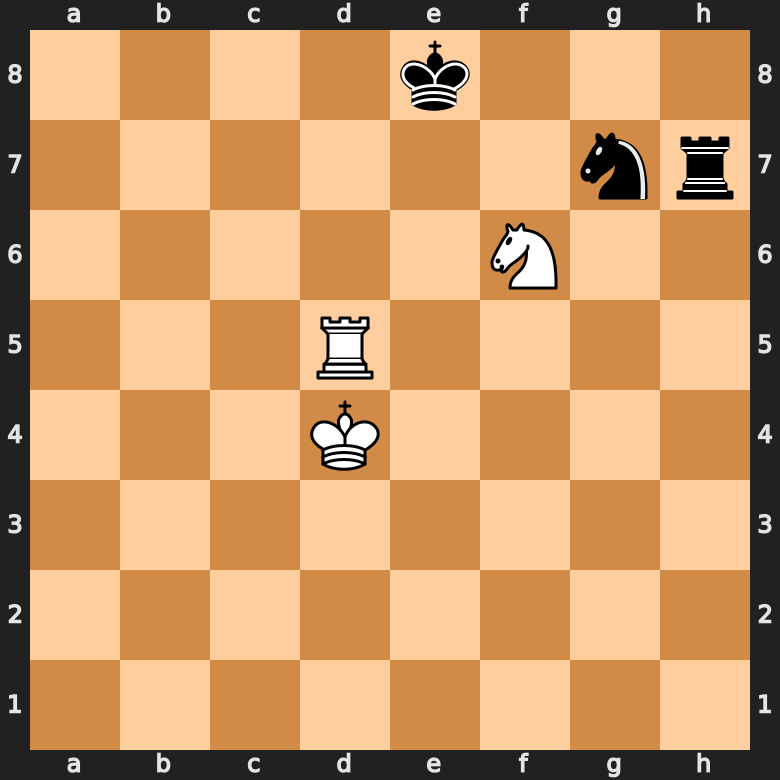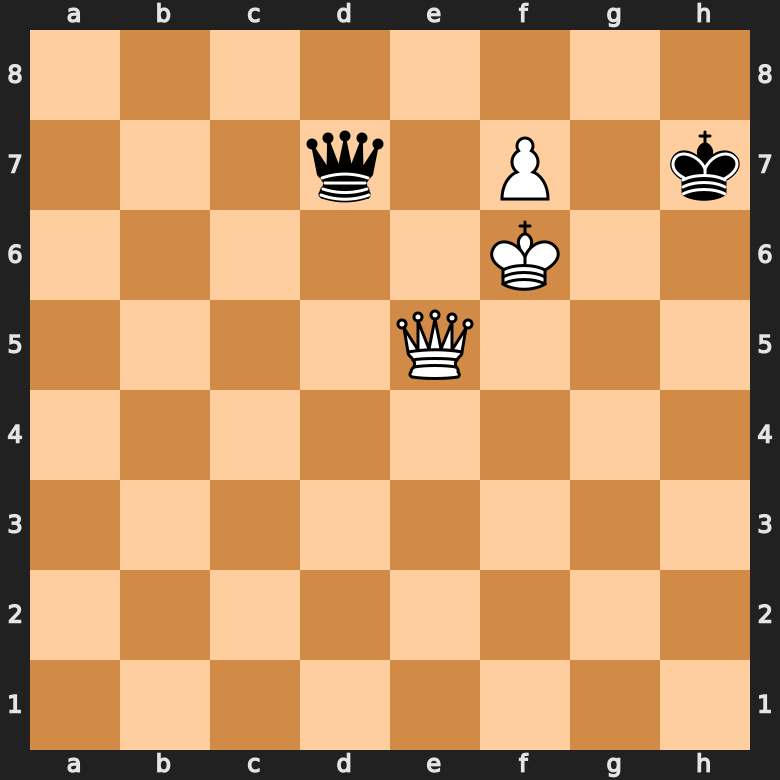The Knight in Chess ♘: Full Guide
The knight is a unique piece in chess. It has a very special way of moving across the board, as well as the ability to jump over other pieces 🦘. So, let’s do a deep-dive into the knight!
Position of the Knights on the Board
In total, there are four nights on the board at the beginning of a game. The two white knights start the game on b1 and g1, while the two black knights begin on b8 and g8, respectively. See this diagram for the knights starting position in chess:

In the starting position the four knights are surrounded by bishops, rooks, as well as pawns. Since the knight is the only piece that can jump over other pieces, it is also the only piece that can start the game immediately, without moving the pawns first.
A common beginner mistake is to swap bishops and knights in the starting position. Make sure your knights are always directly besides your rooks, which always occupy the corner-squares.
How the Knight Moves in Chess
As we have already alluded to, the knight has a unique way of moving across the chess board.
The knight may move two squares horizontally and one vertically, or two squares vertically and one horizontally in any direction. Sounds complicated, but see if you can recognize that pattern in this animation:

A relatively easy way to remember the knight’s movement, is to remember the distinct “L”-pattern it moves in. Two squares vertically and one horizontally (or the other way around).
General Information on the Knight
The knight is considered a minor piece, alongside the bishop. In chess notation, the knight is indicated with the letter N.
Value of the Knight
The knight has a value of roughly 3 pawns. In theory, that makes the knight and bishop worth about the same. However, there are certain positions where the knight excels. In closed positions, the knight is able to jump over blockades, whereas the bishop might be blocked in by a rigid pawn structure, rendering it almost useless.
Knight Strategy
Generally, you want to have the knight as close to the center as possible, where it has the most potential moves. The knight is weakest in corners and the edge of the board, where its movement is restricted the most 👎.
In the center of the board the knight has eight potential squares it can move to, while it only has two squares when in the corner of the board. A good saying to remember is “knights on the rim are dim” 🔅.
Knights can be especially powerful in so-called “outposts”, where they can’t easily be pushed away from:

The knight on d5 has an excellent outpost, dead in the middle of the board. It can never realistically be pushed away, as no pawns can directly attack it. Due to its centered position is attacks eight squares in total.
Often, knights with a strong outpost can be worth about the same as a rook, depending on the position.
Forking with a Knight
A common theme in chess is a knight fork. A fork is a tactic in which a piece attacks at least two enemy pieces at the same time. Since the knight cannot be captured by pieces it is attacking (except by other knights of course), their forks are usually devastating. Have a look at this example:

The white Knight on f6 attacks both rook and king. Since black is forced to defend the check, the knight can easily capture the black rook on h7, winning the game for white.
Checkmating with Two Knights
The two knights endgame is a special type of endgame in chess, in which two knights with their king play against a lone enemy king. While a checkmate with a king and two knights is theoretically posible, the checkmate cannot be forced. That means the opponent needs to play suboptimally (i.e. blunder) to get checkmated.
Paradoxically, it is often possible for two knights and a king to force a checkmate, when the opponent has a few pawns left, as they can be used to prevent a stalemate while checkmating.
Underpromotion to a Knight
Another situation where the knight can play a critical role is in a pawn promotion. There are some positions in which it can be beneficial to underpromote a pawn into a knight, rather than a queen or rook:

Admittedly, underpromotions are very rare. Under 2% of all promotions are underpromotions to a knight, and not all of thise were necessarily the best move.
3 Tips for Getting the Most Out of Your Knights
- Place Your Knights In the Center, Avoid Edges and the Corners
- Create Protected Outposts for your knights
- Use the Knights Ability to Fork Pieces
Knight – Frequently Asked Questions
- How Does the Knight Move in Chess?The knight moves in a distinct L-shape. It can move two squares horizontally + one square vertically, or two squares vertically + one square horizontally in any direction.
- How Many Spaces Can a Knight Move in Chess?That's hard to quantify. The knight moves two squares horizontally and one vertically (or the other way around). So you could say the knight moves three squares with every move.
- Can the Knight Jump Over Other Pieces?Yes, the knight can jump over other pieces. In fact, the knight is the only piece in chess that can jump over others.
- How Many Pawns Is the Knight Worth?The knight is usually said to be worth about three pawns.
- Can the Knight Move Backwards in Chess?Yes, the knight can move in any direction it wants to – even backwards.
- Can You Checkmate With 2 Knights?You cannot force a checkmate against a lone king with two knights (and your king), if your opponent plays perfectly. However, sometimes it is possible to force a checkmate when the opponent has some pawns left.

